《大学英语》课程PPT教学课件(口语二)口语第三次
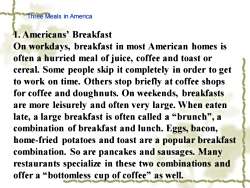
ThreeMealsinAmerical.Americans' BreakfastOn workdays, breakfast in most American homes isoften a hurried meal of juice, coffee and toast orcereal. Some people skip it completely in order to getto work on time. Others stop briefly at coffee shopsfor coffee and doughnuts.On weekends,breakfastsare more leisurely and often very large.When eatenlate, a large breakfast is often called a “brunch", acombination of breakfast and lunch. Eggs, bacon.home-fried potatoes and toast are a popular breakfastcombination. So are pancakes and sausages. Manyrestaurants specialize in these two combinations andoffera“bottomless cupof coffee"aswell
Three Meals in America 1. Americans’ Breakfast On workdays, breakfast in most American homes is often a hurried meal of juice, coffee and toast or cereal. Some people skip it completely in order to get to work on time. Others stop briefly at coffee shops for coffee and doughnuts. On weekends, breakfasts are more leisurely and often very large. When eaten late, a large breakfast is often called a “brunch”, a combination of breakfast and lunch. Eggs, bacon, home-fried potatoes and toast are a popular breakfast combination. So are pancakes and sausages. Many restaurants specialize in these two combinations and offer a “bottomless cup of coffee” as well
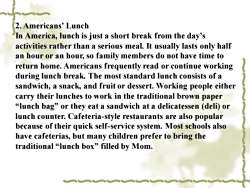
2.Americans'LunchIn America, lunch is just a short break from the day'sactivities rather than a serious meal. It usually lasts only halfan hour or an hour, so family members do not have time toreturn home. Americans frequently read or continue workingduring lunch break. The most standard lunch consists of asandwich, a snack, and fruit or dessert. Working people eithercarry their lunches to work in the traditional brown paper"lunch bag" or they eat a sandwich at a delicatessen (deli) orlunch counter. Cafeteria-style restaurants are also popularbecause of their quick self-service system. Most schools alsohave cafeterias, but many children prefer to bring thetraditional"lunch box" filled by Mom
2. Americans’ Lunch In America, lunch is just a short break from the day’s activities rather than a serious meal. It usually lasts only half an hour or an hour, so family members do not have time to return home. Americans frequently read or continue working during lunch break. The most standard lunch consists of a sandwich, a snack, and fruit or dessert. Working people either carry their lunches to work in the traditional brown paper “lunch bag” or they eat a sandwich at a delicatessen (deli) or lunch counter. Cafeteria-style restaurants are also popular because of their quick self-service system. Most schools also have cafeterias, but many children prefer to bring the traditional “lunch box” filled by Mom
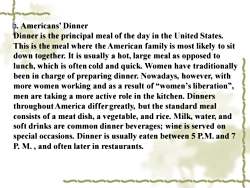
3.Americans'DinnerDinner is the principal meal of the day in the United States.This is the meal where the American familyis most likely to sitdown together. It is usually a hot, large meal as opposed tolunch, which is often cold and guick. Women have traditionallybeen in charge of preparing dinner. Nowadays, however, withmore women working and as a result of “women's liberation'men are taking a more active role in the kitchen. DinnersthroughoutAmerica differgreatly, but the standard mealconsists of a meat dish, a vegetable, and rice. Milk, water, andsoft drinks are common dinner beverages; wine is served onspecial occasions.Dinner is usually eaten between 5 P.M. and 7P.M.and oftenlaterin restaurants
3. Americans’ Dinner Dinner is the principal meal of the day in the United States. This is the meal where the American family is most likely to sit down together. It is usually a hot, large meal as opposed to lunch, which is often cold and quick. Women have traditionally been in charge of preparing dinner. Nowadays, however, with more women working and as a result of “women’s liberation”, men are taking a more active role in the kitchen. Dinners throughout America differ greatly, but the standard meal consists of a meat dish, a vegetable, and rice. Milk, water, and soft drinks are common dinner beverages; wine is served on special occasions. Dinner is usually eaten between 5 P.M. and 7 P. M. , and often later in restaurants
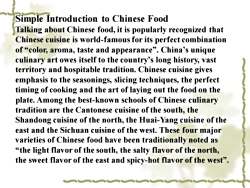
Simple Introduction to Chinese FoodTalking about Chinese food, it is popularly recognized thatChinese cuisine is world-famous for its perfect combinationof “color, aroma, taste and appearance". China's uniqueculinary art owes itself to the country's long history, vastterritory and hospitable tradition. Chinese cuisine givesemphasis to the seasonings, slicing techniques, the perfecttiming of cooking and the art of laying out the food on theplate. Among the best-known schools of Chinese culinarytradition are the Cantonese cuisine of the south, theShandong cuisine of the north, the Huai-Yang cuisine of theeast and the Sichuan cuisine of the west. These four majorvarieties of Chinese food have been traditionallynoted asthe lightflavor of the south, the salty flavor of the north.the sweet flavor of the east and spicy-hot flavor of the west
Simple Introduction to Chinese Food Talking about Chinese food, it is popularly recognized that Chinese cuisine is world-famous for its perfect combination of “color, aroma, taste and appearance”. China’s unique culinary art owes itself to the country’s long history, vast territory and hospitable tradition. Chinese cuisine gives emphasis to the seasonings, slicing techniques, the perfect timing of cooking and the art of laying out the food on the plate. Among the best-known schools of Chinese culinary tradition are the Cantonese cuisine of the south, the Shandong cuisine of the north, the Huai-Yang cuisine of the east and the Sichuan cuisine of the west. These four major varieties of Chinese food have been traditionally noted as “the light flavor of the south, the salty flavor of the north, the sweet flavor of the east and spicy-hot flavor of the west
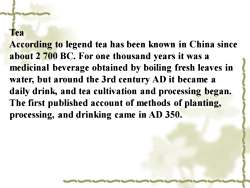
TeaAccording to legend tea has been known in China sinceabout 2 7o0 BC. For one thousand years it was amedicinal beverage obtained by boiling fresh leaves inwater, but around the 3rd century AD it became adaily drink, and tea cultivation and processing beganThe first published account of methods of planting:processing, and drinking came in AD 350
Tea According to legend tea has been known in China since about 2 700 BC. For one thousand years it was a medicinal beverage obtained by boiling fresh leaves in water, but around the 3rd century AD it became a daily drink, and tea cultivation and processing began. The first published account of methods of planting, processing, and drinking came in AD 350
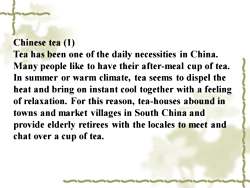
Chinese tea (1)Tea has been one of the daily necessities in China.Many people like to have their after-meal cup of tea.In summer or warm climate, tea seems to dispel theheat and bring on instant cool together with a feelingof relaxation. For this reason, tea-houses abound intowns and market villages in South China andprovide elderly retirees with the locales to meet andchat over a cup of tea
Chinese tea (1) Tea has been one of the daily necessities in China. Many people like to have their after-meal cup of tea. In summer or warm climate, tea seems to dispel the heat and bring on instant cool together with a feeling of relaxation. For this reason, tea-houses abound in towns and market villages in South China and provide elderly retirees with the locales to meet and chat over a cup of tea
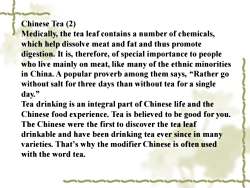
Chinese Tea (2)Medically, the tea leaf contains a number of chemicals.which help dissolve meat and fat and thus promotedigestion. It is, therefore, of special importance to peoplewho live mainly on meat, like many of the ethnic minoritiesin China. A popular proverb among them says, “Rather gowithout salt for three days than without tea for a singleday."Tea drinking is an integral part of Chinese life and theChinese food experience. Tea is believed to be good for you.The Chinese were the first to discover the tea leafdrinkable and have been drinking tea ever since in manyvarieties. That's why the modifier Chinese is often usedwith the word tea
Chinese Tea (2) Medically, the tea leaf contains a number of chemicals, which help dissolve meat and fat and thus promote digestion. It is, therefore, of special importance to people who live mainly on meat, like many of the ethnic minorities in China. A popular proverb among them says, “Rather go without salt for three days than without tea for a single day.” Tea drinking is an integral part of Chinese life and the Chinese food experience. Tea is believed to be good for you. The Chinese were the first to discover the tea leaf drinkable and have been drinking tea ever since in many varieties. That’s why the modifier Chinese is often used with the word tea
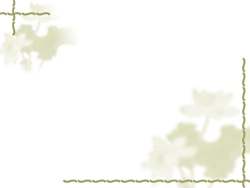
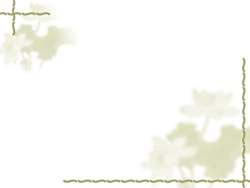
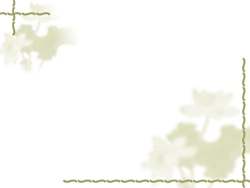
按次数下载不扣除下载券;
注册用户24小时内重复下载只扣除一次;
顺序:VIP每日次数-->可用次数-->下载券;
- 《大学英语》课程PPT教学课件(口语二)口语第四次.ppt
- 《大学英语》课程PPT教学课件(口语二)口语第五次.ppt
- 《大学英语》课程PPT教学课件(口语二)口语第一次.ppt
- 《大学英语》课程PPT教学课件(口语二)口语第八次.ppt
- 《大学英语》课程PPT教学课件(口语二)口语第二次.ppt
- 《大学英语》课程PPT教学课件(口语二)口语第九次.ppt
- 《大学英语》课程PPT教学课件(口语二)口语第六次.ppt
- 《大学英语》课程PPT教学课件(口语二)口语第七次.ppt
- 《大学英语》课程PPT教学课件(口语一)Unit Two Learning online.ppt
- 《大学英语》课程PPT教学课件(口语一)Unit Three Cellphone.ppt
- 《大学英语》课程PPT教学课件(口语一)Unit Six Music.ppt
- 《大学英语》课程PPT教学课件(口语一)Unit Seven Generation gap.ppt
- 《大学英语》课程PPT教学课件(口语一)Unit One Self-introduction.doc
- 《大学英语》课程PPT教学课件(口语一)Unit Four Family love.ppt
- 《大学英语》课程PPT教学课件(口语一)Unit Five Calamites & Rescue.ppt
- 《大学英语》课程PPT教学课件(口语一)Unit Eight Holiday.ppt
- 《大学英语》课程试卷习题(大学英语四级【CET-4】历年真题大全,1989-2007年39套,含参考答案).docx
- 《大学英语》课程参考资料(作文写作)应试技巧-阅读理解.doc
- 《大学英语》课程参考资料(作文写作)U.S. to Start $3.2 Billion Child Health Study in January.doc
- 《大学英语》课程参考资料(作文写作)Calling for Safe Celebrations This Fourth of July.doc
- 《大学英语》课程PPT教学课件(口语二)口语第十次.ppt
- 《大学英语》课程PPT教学课件(翻译)第七章 省略法.ppt
- 《大学英语》课程PPT教学课件(翻译)翻译第三周.ppt
- 《大学英语》课程PPT教学课件(翻译)翻译第四周.ppt
- 《大学英语》课程PPT教学课件(翻译)英汉翻译第一周.ppt
- 《大学英语》课程PPT教学课件(翻译)英语翻译第二周 课件.ppt
- 《大学英语》课程PPT教学课件(翻译)第11周 语态变换法.ppt
- 《大学英语》课程PPT教学课件(翻译)第12周 倒置法.ppt
- 《大学英语》课程PPT教学课件(翻译)第九周课件.ppt
- 《大学英语》课程PPT教学课件(翻译)第八章 重译法.ppt
- 《大学英语》课程PPT教学课件(翻译)第十周课件.ppt
- 《大学英语》课程PPT教学课件(翻译)第5-6周 词类转换和增译法.ppt
- 《大学英语》课程PPT教学课件(英语国家概况)American Holidays.ppt
- 《大学英语》课程PPT教学课件(英语国家概况)Australia.ppt
- 《大学英语》课程PPT教学课件(英语国家概况)Canada.ppt
- 《大学英语》课程PPT教学课件(英语国家概况)Ireland.ppt
- 《大学英语》课程PPT教学课件(英语国家概况)New Zealand.ppt
- 《大学英语》课程PPT教学课件(英语国家概况)the Great Britain.ppt
- 《大学英语》课程PPT教学课件(英语国家概况)The U.S.ppt
- 《大学英语》课程PPT教学课件(英美文化基础)1.Atlantic_to_Pacific.ppt
